pale grass blue
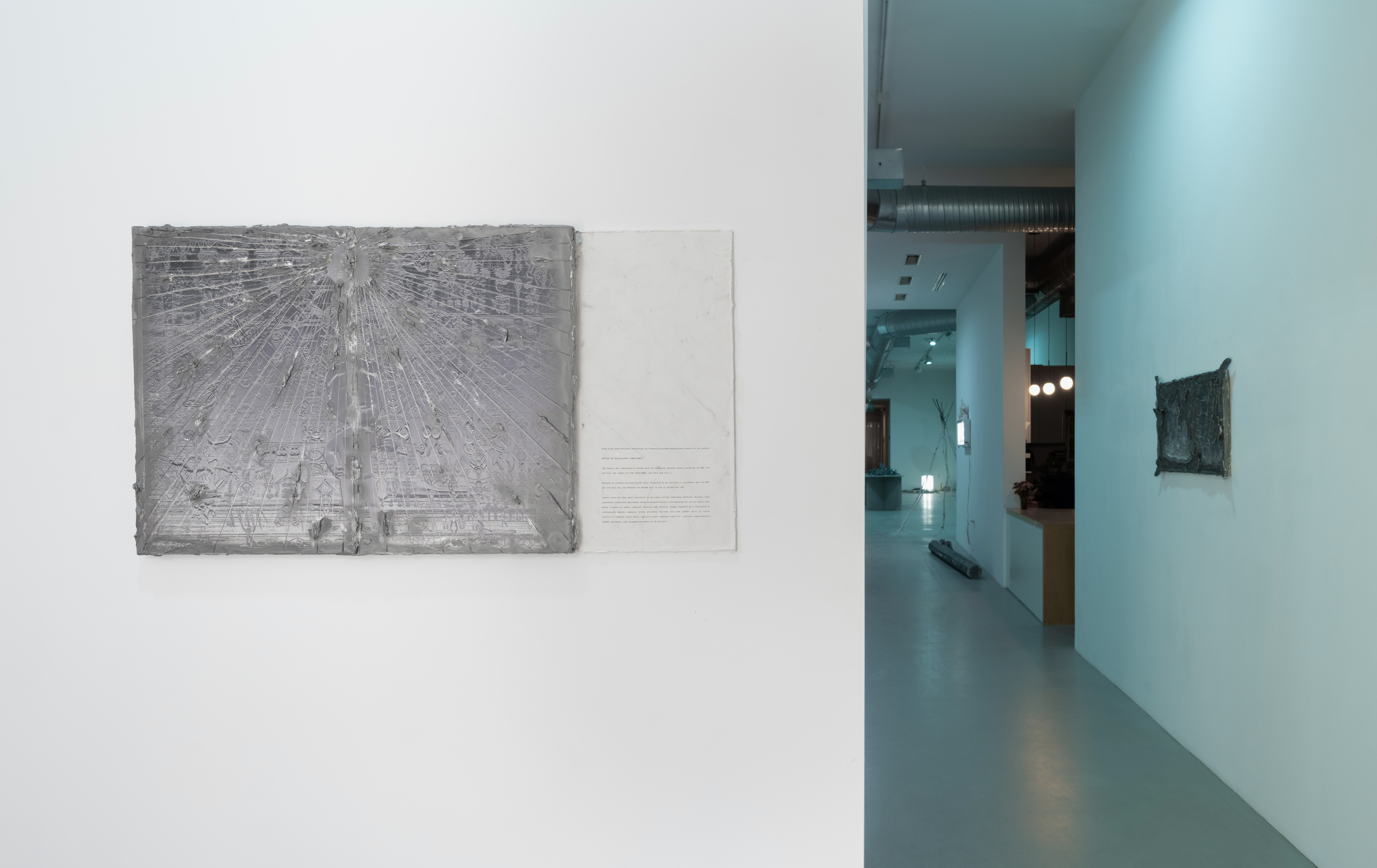
Pale Grass Blue builds upon the idea that ecocide, wars, body politics, avant-garde, religion, and capital exist as sorts of radioactive events, altering and reshaping the genome of what we term reality. As these normalized actions seep toxins into the fabric of socio-political environments and geographical landscapes, things become increasingly blurry, hazy, and loopy. By addressing this unsettling feeling through creating a landscape of installations, objects, and text, this project explores how constructed realities could function as vehicles for resistance, introspection, and the reclamation of agency.



The exhibition consists of nine works, each paired with an instruction piece that either comments on the work, reveals how it was made, or explains how it can potentially be activated.


(epigraph instruction or how to view unshielded radioactive specimen in the gallery), 2024, 48 x 24 in, wallboard base, relief compound, spray pigment, archival ink
Text of the instruction:
NOTICE OF REGULATORY COMPLIANCE
The Gallery was instructed to comply with the following radiation safety standards: US NRC (10 CFR Part 20), OSHA (29 CFR 1910.1096), and IAEA GSR Part 3.
Samples of uranium ore and caesium-137 were instructed to be obtained in accordance with US NRC (10 CFR Part 40) and NYSDOH (10 NYCRR Part 16 and 12 NYCRR Part 38).
Safety measures that were instructed to be taken include indicating sufficient distance from unshielded radioactive specimens; using designated barriers; and applying the inverse square law, which intended to reduce radiation intensity with distance. Geiger counters were instructed to continuously monitor exposure levels, providing real-time data and audible alerts to inform visitors of radiation levels within regulated public exposure limits of 1 Sv/year (approximately 0.0001 µSv/h/hour), with occupational limits at 20 µSv/year.


 Cares of the Family Man, 2024, video (social media feed); smartphone, measuring tapes, flood lights, sand, textile strands and relief compound, dimensions variable
Cares of the Family Man, 2024, video (social media feed); smartphone, measuring tapes, flood lights, sand, textile strands and relief compound, dimensions variableThis group of works maps my research as a « radioactive site » of confusion amid socio-political chaos, where personal and impersonal aspects blur. By exploring its roots, I attempt to relate to it.
Referencing various interpretations of the idea of « site »—, archaeological, burial, or simply the space my body occupied on a beach where I spent part of my summer working on this exhibition via my phone—my process mirrors often vain and erratic nature of doom-scrolling and the shifting focus of my research, as displayed on social media feeds.
The title and elements of installation are inspired by Kafka’s surreal story « The Cares of a Family Man, » where Odradek, a strange object, unsettles the narrator because it might outlive him—as story that is often seen as a critique of religion, capitalism, and patriarchy.
The installation serves as both the introduction and conclusion of the exhibition. As viewers exit, they retrace their steps, reinforcing the experience as a continuous loop—much like the platform where the work is presented.
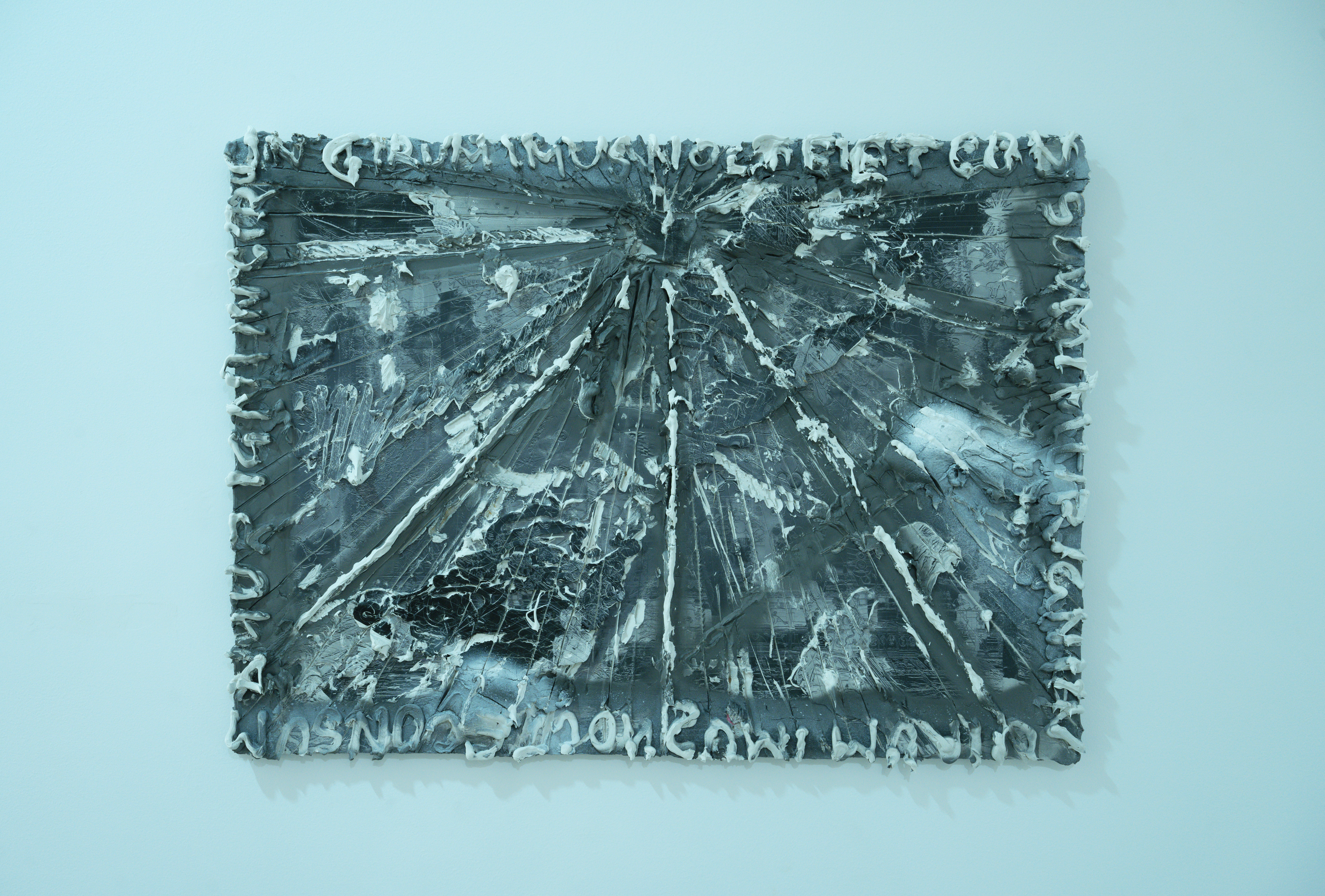 NOCTE/IGNI, 2024, wallboard base, relief compound, spray pigment and archival ink, 24 x 32 in
NOCTE/IGNI, 2024, wallboard base, relief compound, spray pigment and archival ink, 24 x 32 in (stranding instruction or how to mesh a radioactive site), 2024, textile strands, wallboard base, relief compound, spray pigment and archival ink, 17 x 25 in
(stranding instruction or how to mesh a radioactive site), 2024, textile strands, wallboard base, relief compound, spray pigment and archival ink, 17 x 25 inText of the instruction:
research the following markers to mesh pale grass blue habitation site:
#anthropocene #darkecology #redforest #zoneofexclusion #corium #elephantfoot #mutatedpalegrassblue #fallout #precarity #dehumanization #melancholia #hypocrisy #uncannyvalley #junk #e-waste #plasticwaste #strangequarkflavor #halfdecay #archeology #fossilization #chauvetcave #russiandoll #hostilearchitecture #dogandababy #nuclearchurch #controlrod #chainreaction # modern art #hyperchaos #siren #demonicforces #sigmarpolke #celebration #tarbaby #odradek #drone #stereogram #lestroispetitscochons #wolfhour #cyanide #spectre #somewheresomewhere #silicates #lump #membrane #goo #avatar #dna #doom #futurefutur #somewheresomewhere

I often work with text and use it in different capacities. In this regard, these instructions—which have the quality of an ancient tablet, even made out of a sort of fossil—also express somewhat religious qualities and, in some ways, remind one of medieval or Orthodox icons. The text can often be read, but sometimes it is illegible, hidden, or the viewer can see only remnants of it. In a certain way, such an approach—as well as the content of the instruction that often mocks bureaucratic style—intends to show the failure of text, which, by being disrupted, misused, and abused with different contradicting narratives, loses some of its primary function to be an instrument of reasoning and conveying meaning.

elephant foot (corium series), 2024, 60 x 90 x 17 in, wallboard base, relief compound, ceramics, spray pigment, archival ink


The group of works under the exhibition pale grass blue title is an installation paired with instruction piece that blends personal transformation, environmental consciousness, and existential contemplation against the backdrop of radiation’s lasting impact. It explores the idea of dissolving human identity into completly different entities—a mineral, an insect, or even radioactive ash. Moving through exclusion zones filled with wildlife, it contrasts the sterile fallout with the thriving life that subtly reclaims abandoned spaces. Eventually this piece became a reflection on vulnerability and our ability of conscious for our environment, suggesting a strange beauty in the long shadows of radiation and the haunting legacy it leaves—a quiet resilience, mirrored in the mutated « pale grass blue » butterfly, as a symbol of survival amidst decay.

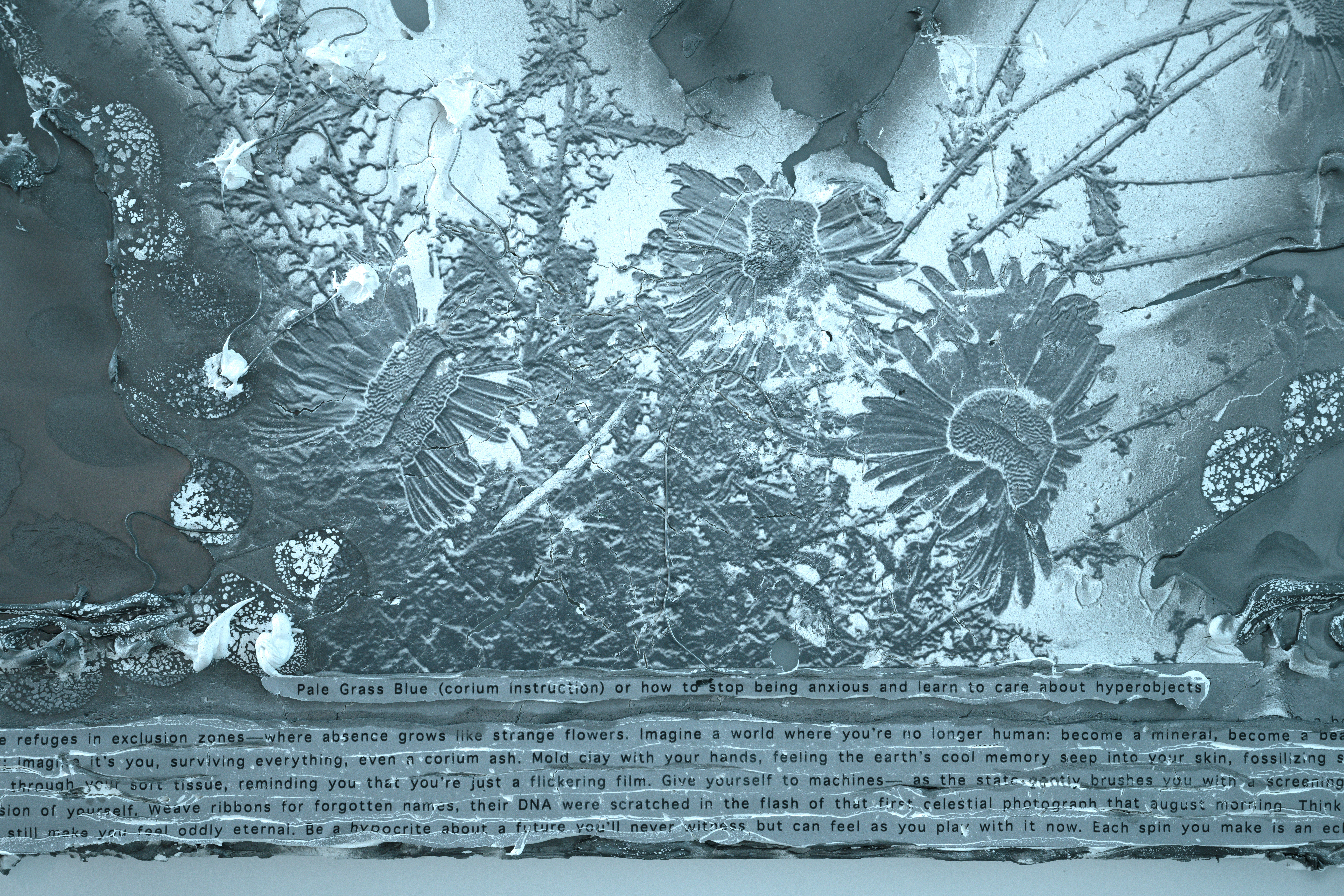 (pale grass blue (corium) instruction or how to stop being anxious and learn to care about radiation), 2024, 40 x 24 in, wallboard base, relief compound, spray pigment, acrylic sheet, solder thread, archival ink
(pale grass blue (corium) instruction or how to stop being anxious and learn to care about radiation), 2024, 40 x 24 in, wallboard base, relief compound, spray pigment, acrylic sheet, solder thread, archival inkText of the instruction:
Swipe through pictures of wildlife refuges in exclusion zones—where absence grows like strange flowers. Imagine a world where you’re no longer human: become a mineral, become a beach, let your edges blur. Read that story of someone morphing into an insect; imagine it’s you, surviving everything, even a corium ash. Mold clay with your hands, feeling the earth’s cool memory seep into your skin, fossilizing slowly. Contemplate as tiny reactors around you glow, their queer quarks filtering through your soft tissue, reminding you that you’re just a flickering film. Give yourself to machines— as the state gently brushes you with a screening stick, while you wait to leave another small carbon message for a future version of yourself. Weave ribbons for forgotten names, their DNA were scratched in the flash of that first celestial photograph that august morning. Think of the waste buried deep below, and how being gone for thousands of years can still make you feel oddly eternal. Be a hypocrite about a future you’ll never witness but can feel as you play with it now. Each spin you make is an echo of a mutated pale grass blue.

The exhibition title Pale Grass Blue, which also gives the show a certain color palette, comes from a species of butterfly whose shape, wing patterns, and coloration underwent severe mutations supposedly after the Fukushima nuclear accident.


pale gras blue (corium series), 2024, dimensions variable, wallboard base, relief compound, ceramics, spray pigment, silver, x-ray box.

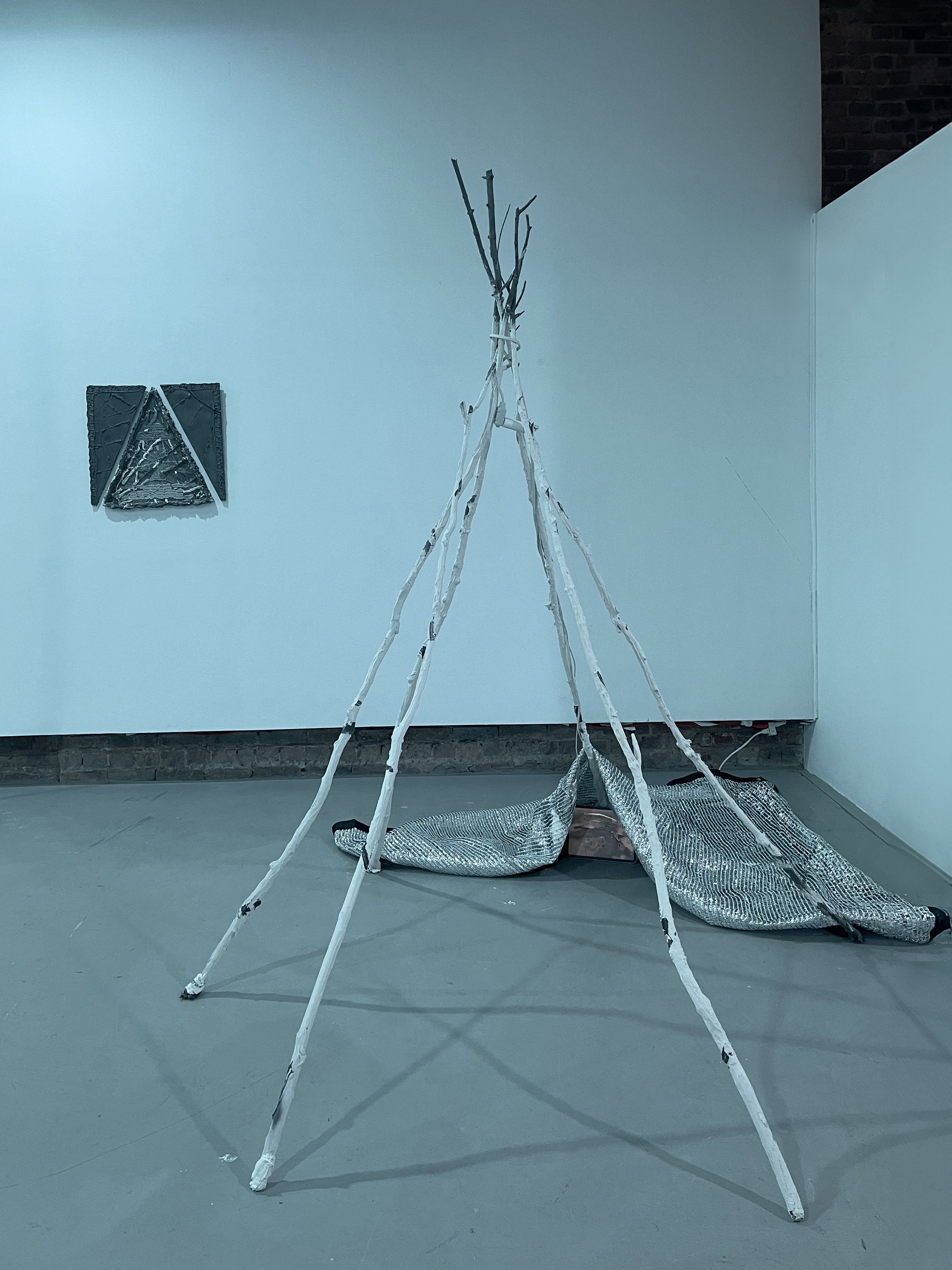 Think of the stick-built hut in the installation as a tangible nod to The Three Little Pigs: it’s fragile by design, much like the second pig’s house of sticks. In the folktale, the wolf easily destroys anything less solid than brick, underscoring how makeshift shelters crumble under overwhelming force. In this installation, that force shows up as war drones hunting each other in the footage - and an instruction for surviving a nuclear apocalypse—mirroring the wolf’s relentless pursuit.
Think of the stick-built hut in the installation as a tangible nod to The Three Little Pigs: it’s fragile by design, much like the second pig’s house of sticks. In the folktale, the wolf easily destroys anything less solid than brick, underscoring how makeshift shelters crumble under overwhelming force. In this installation, that force shows up as war drones hunting each other in the footage - and an instruction for surviving a nuclear apocalypse—mirroring the wolf’s relentless pursuit.This sense of vulnerability also echoes Melancholia, where disaster feels inevitable, reminding us that even our best defenses are sometimes no matc;h for forces beyond our control. As such, the hut makes that tension physical: part fairytale fragility, part real—or cosmic—anxiety about how secure our “safe havens” really are.


Precarity (Les Trois Petits Cochons Mélancoliques) or (Vocabulary series), 2024, dimensions variable, wood, relief compound, ceramics, spray pigment, found footage on tablet device

 precarious/melancholic
instruction or how to build a shelter to protect yourself and your family in
face of a planet radioactive destruction), 2024, 21 x 20 in, wallboard base,
relief compound, archival ink, spray pigment, textile strands
precarious/melancholic
instruction or how to build a shelter to protect yourself and your family in
face of a planet radioactive destruction), 2024, 21 x 20 in, wallboard base,
relief compound, archival ink, spray pigment, textile strandsText of instruction:
Go find sticks
Collect a dozen of them somewhat longer than your height
Select three sturdy sticks
Form a tripod
Take remaining sticks (leave one)
Lean them against the tripod spacing them evenly
Enter the shelter and put the remaining stick to block the entrance


A series of plaster-coated cotton strands reveal testimonies from families who witnessed the Russia-Ukraine war. These stories were collected by a member of network of volunteers who was hosting refugee families transiting through Russia to Europe in their apartment in Saint Petersburg. Written in an unembellished, almost documentary style, these narratives are honest and often unsettling and moving accounts of both the resilience and fragility of everyday life and human existence.
A selection of these stories, which I hope will one day be fully published, first appeared on social media. For this project, they were translated into English and edited in collaboration with their author, who, under mounting state pressure on the platform, requested that their name and account remain undisclosed. The decision to display them on strands was made to evoke a sense of domesticity while also reflecting the nature of a digital feed and evoking the fossilization and archaeology of both history and individual lives. As these testimonies settle beneath layers of media, they become one of the focal points of this exhibition’s research.


Witnesses, 2024, dimensions variable, textile strands, relief compound, spray pigment, archival ink

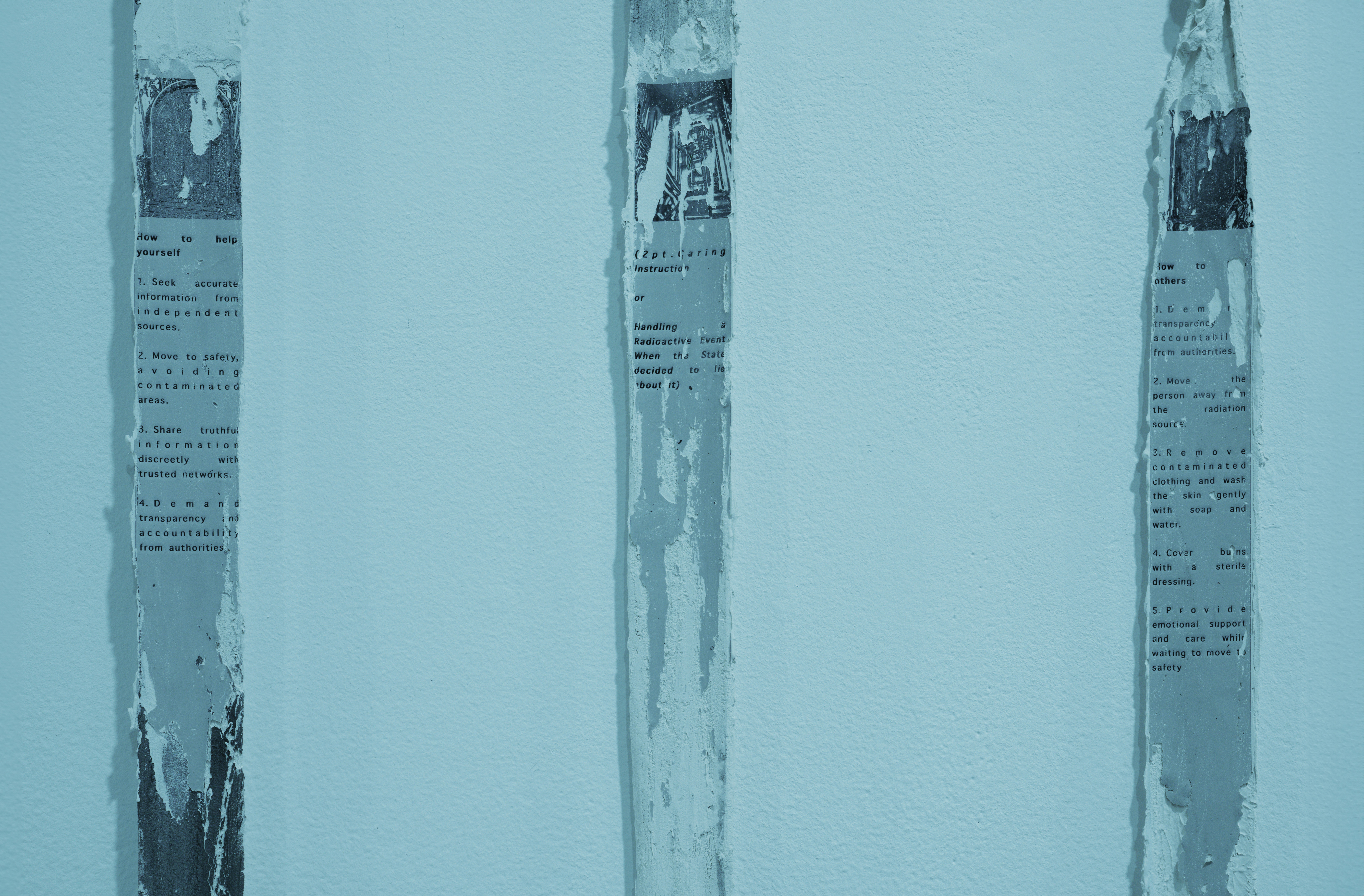
(caring instruction or how to handle a radioactive event when the state decided to lie about it), 2024, 57x19 in, relief compound, spray pigment, textile strands, gauzes, archival ink
Text of instruction:
How to help yourself
1. Seek accurate information from independent sources.
2. Move to safety, avoiding contaminated areas.
3. Share truthful information discreetly with trusted networks.
4. Demand transparency and accountability from authorities.
How to help others
1. Demand transparency and accountability from authorities.
2. Move the person away from the radiation source.
3. Remove contaminated clothing and wash the skin gently with soap and water.
4. Cover burns with a sterile dressing.
5. Provide emotional support and care while waiting to move to safety
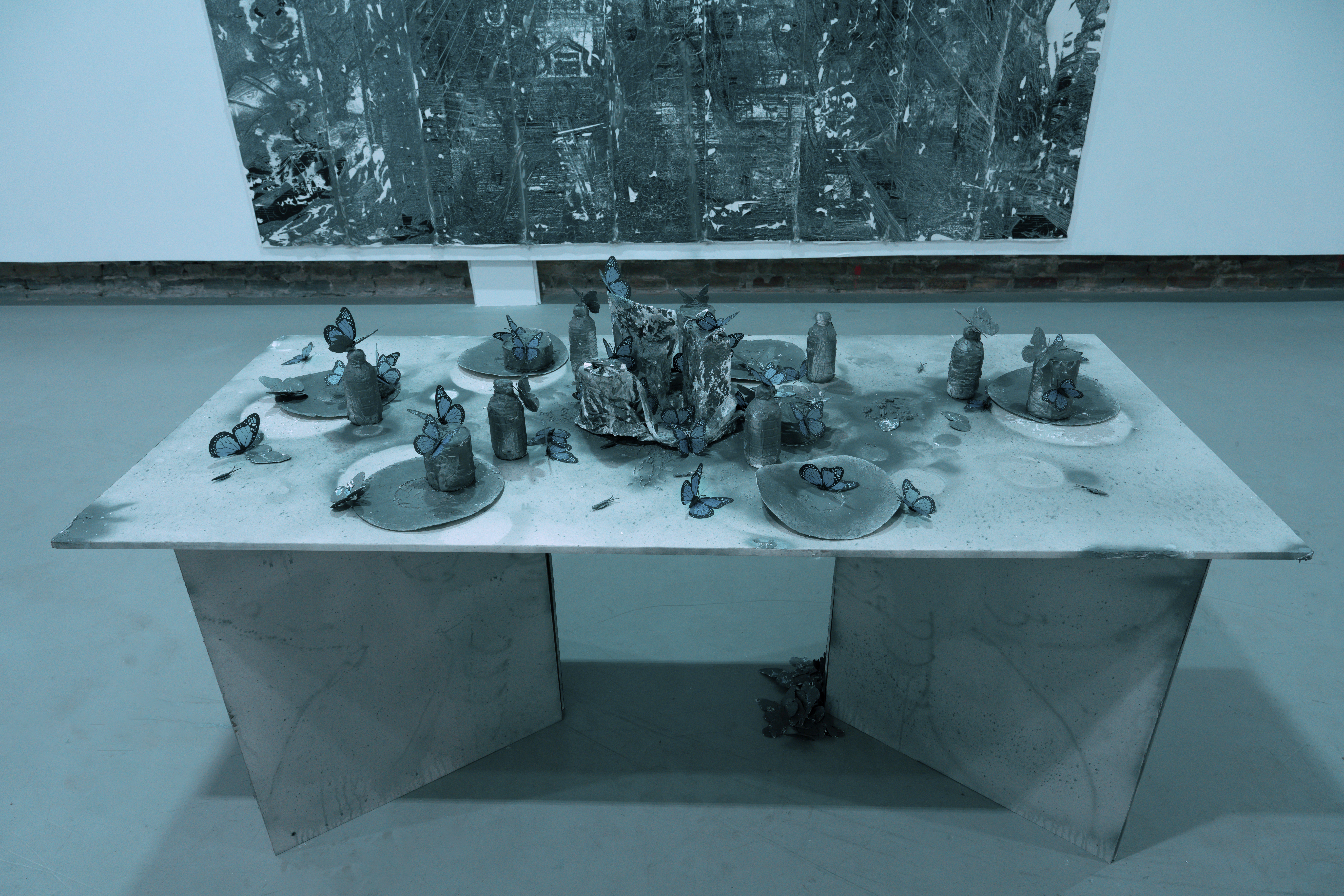

A table arranged with food recommended for evacuation events, inspired by photographs of desolated urban environments where people abandoned their homes on short notice, leaving produce behind. These food arrangements resembled vanitas paintings, reflecting on life's transience amid the perpetual cycles of rebirth and decay invading our reality.
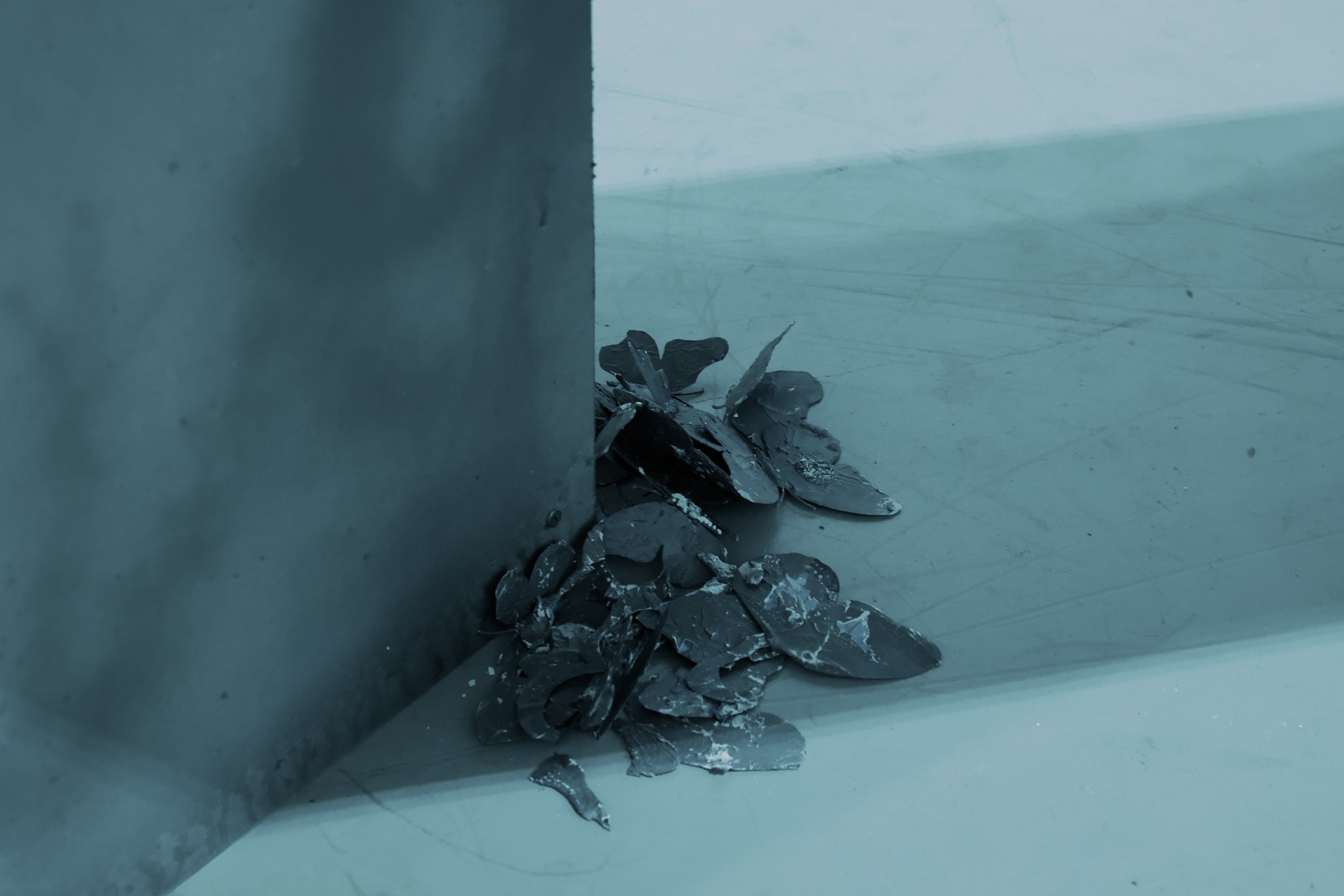
 Vanitas (table series), 2024, 74 x 32 x 27 in, wallboard base, pigment spray, relief
compound, canned and dry produce, metal, synthetic resin
Vanitas (table series), 2024, 74 x 32 x 27 in, wallboard base, pigment spray, relief
compound, canned and dry produce, metal, synthetic resin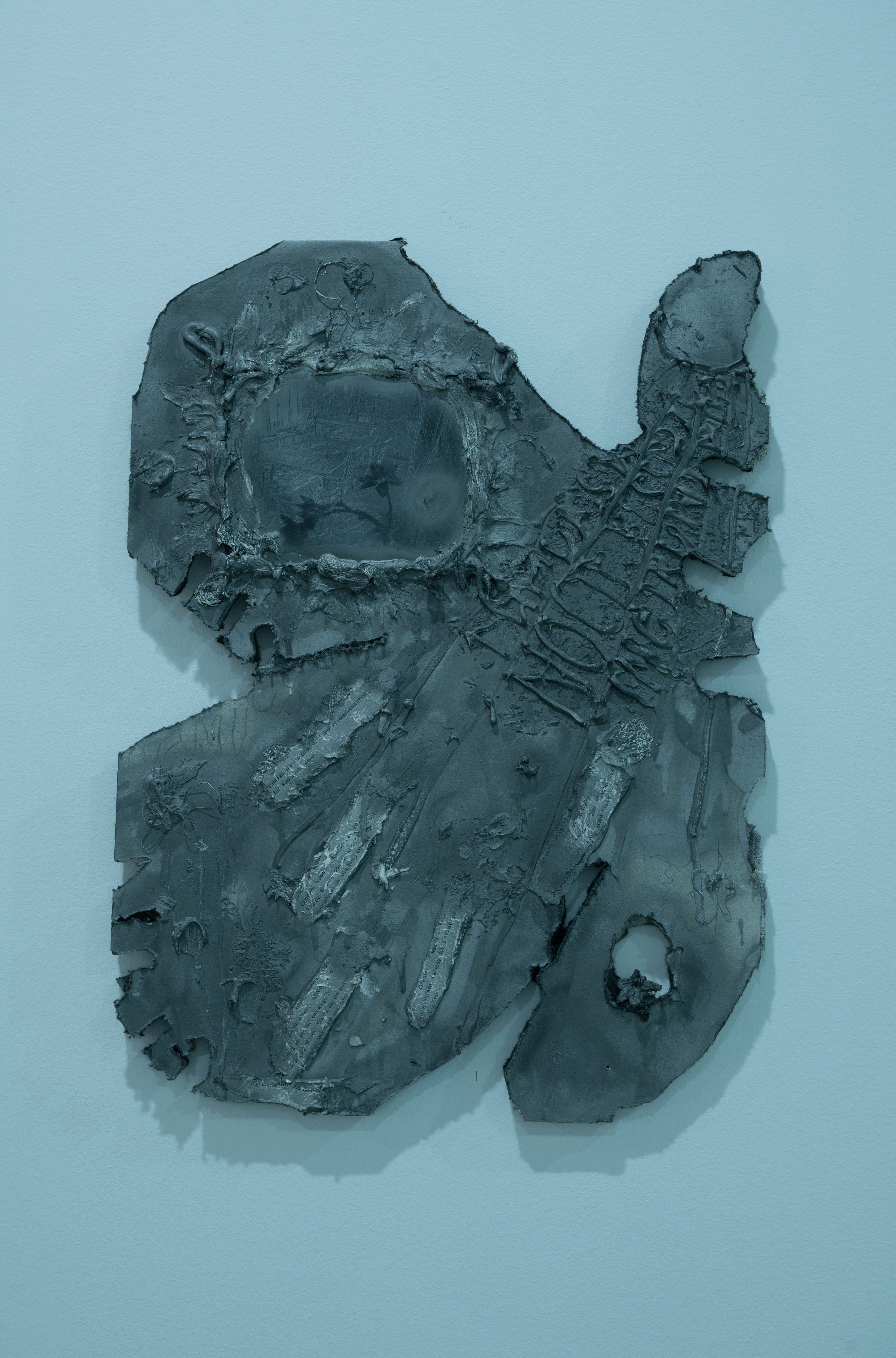
 (vanitas instruction
or food recommendation for radiation zone), 2024, 23x17 in, wallboard base,
relief compound, spray pigment, synthetic film, alloy thread, archival ink
(vanitas instruction
or food recommendation for radiation zone), 2024, 23x17 in, wallboard base,
relief compound, spray pigment, synthetic film, alloy thread, archival inkText of instruction:
Collect the following:
Canned Goods: Choose canned vegetables, fruits, beans, soups, and meats—safe from contamination and long-lasting.
Packaged and Dried Foods: opt for rice, pasta, dried beans, lentils, and dehydrated meals in sealed packaging.
Bottled Water: Stock up on bottled water to avoid contaminated sources.
MREs (Meals Ready-to-Eat): Use military-grade rations for a ready-made, safe food option.
Sealed Snacks: Include airtight snacks like crackers, nuts, and dried fruits.
Vacuum-Sealed Foods: Use vacuum-sealed meats, cheeses, and dried foods to prevent contamination.
Leave any contaminated behind.


The Room, a large-scale wall piece that uses AI, almost a religious belief in new technology, and addresses another controversy around it—potential use of nuclear power as a source of its energy—features the quality hieroglyphs and iconography, reflecting the religious aspects of the show. It portrays religion as a relic form of radiation, hence the common notion of the Last Supper vis-à-vis the vanitas arrangement of the table and the radiating sun—a repeating symbol of many convictions.


the room, 2024, 8 x 12 ft, wallboard base, pigment spray, relief compound, archival ink

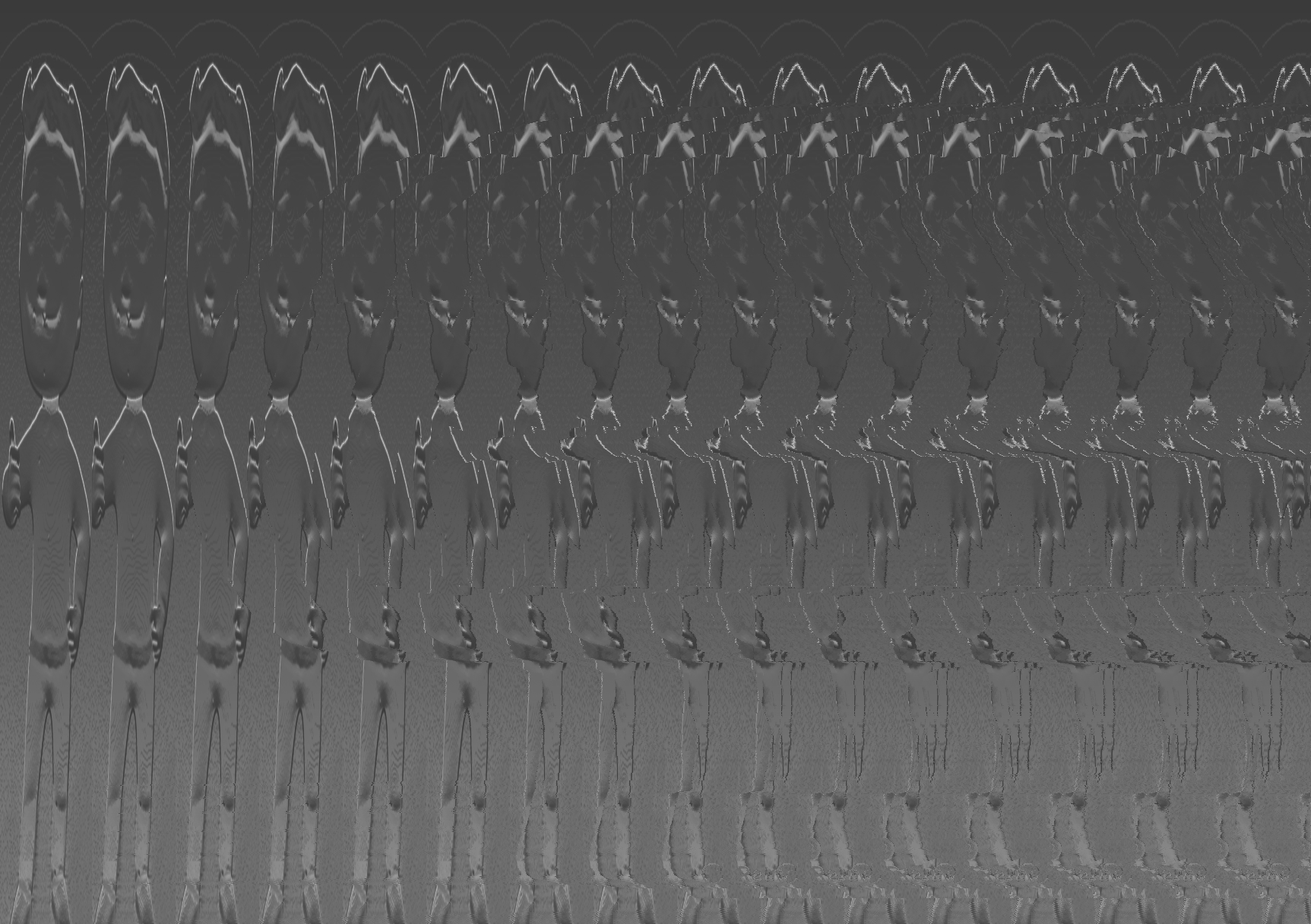

(stereogram instruction or how to see a full picture), 2024, 15x16 in, acrylic sheet, relief compound, spray pigment, archival ink, silver
Text of instruction:
Take a comfortable distance from the picture. Try not to think of what is on the picture. Relax your eyes and try to look through the picture, not directly at it, as if you're gazing at a point behind it. Slowly adjust your focus while keeping your eyes relaxed until an image begins to emerge. Keep your eyes steady once an image appears. Enjoy the depth of the hidden scene.
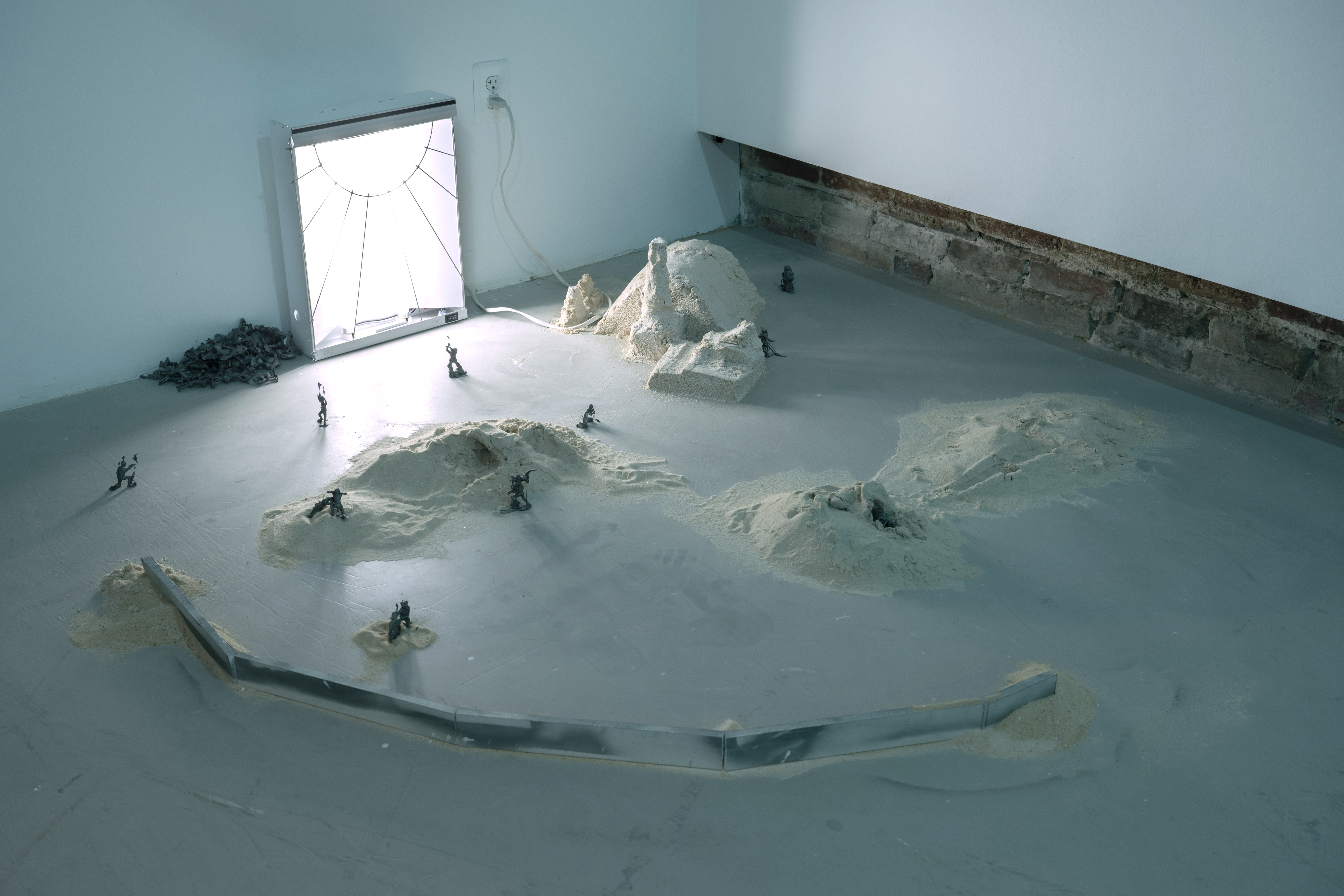 hello red forest, hello soil, 2024, dimensions variable, sand, synthetic resin, spray pigment,
metal, wallboard base, relief compound, metal
hello red forest, hello soil, 2024, dimensions variable, sand, synthetic resin, spray pigment,
metal, wallboard base, relief compound, metal


This work reflects on the March 2022 events where Russian forces crossed the Red Forest exclusion zone digging trenches in highly radioactive soil—treating it as a militarize playground. Paradoxically, while seeking protection from external threats, greater danger lay within these shelters. An accompanying text - an instruction and a poem - which heavy, bas-relief form draws parallels to the memorial plaque presented as a cautionary list of what not to do when visiting natural and “technogenic” radioactive sites, underscores the topological quality of these areas as transitional zones (or “non-sites”) and the haunting nature of trauma embedded within them.
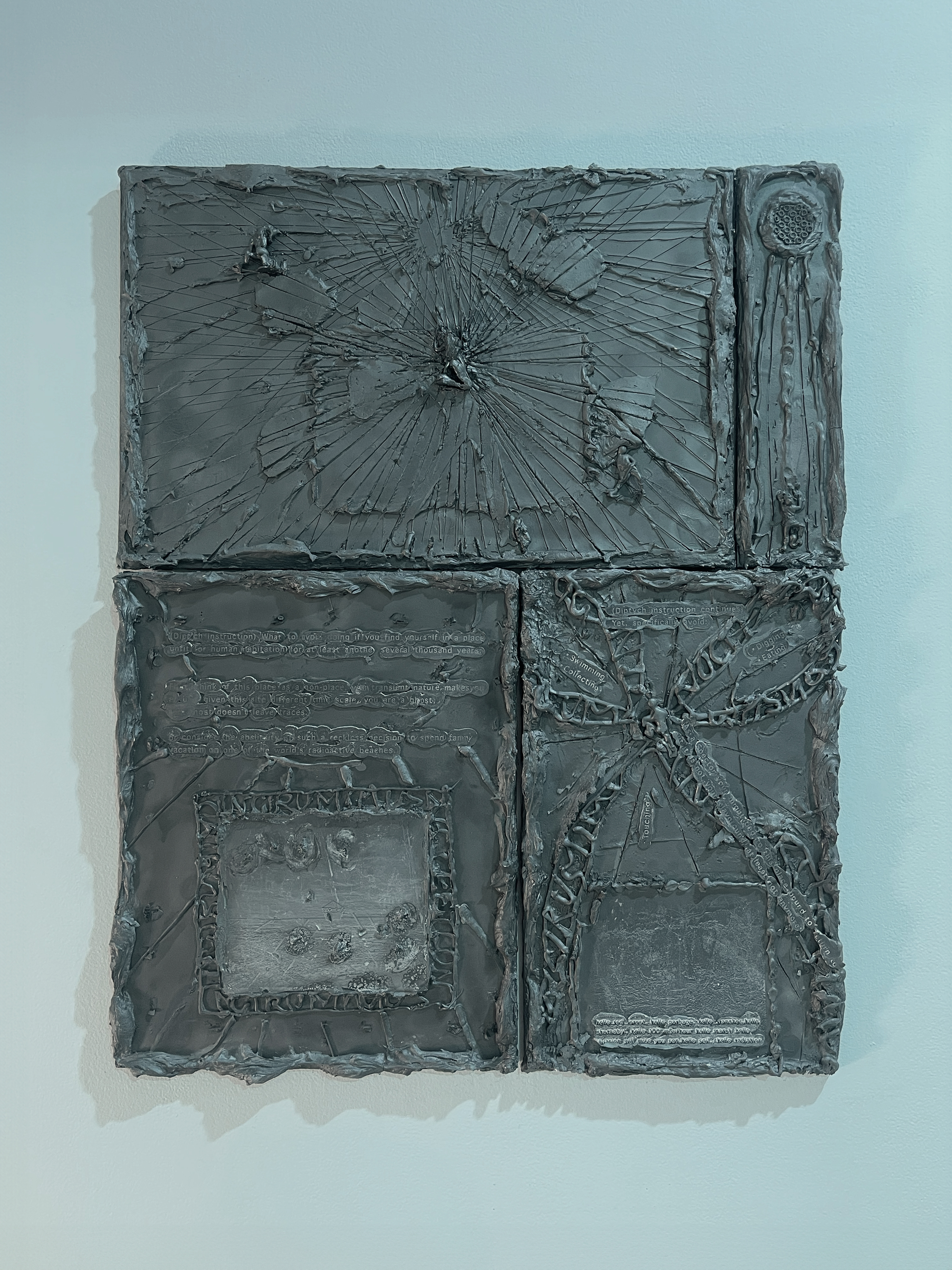

(diptych instruction or what to avoid doing if you find yourself in a place unfit for human habitation for at least another several thousand years), 2024, 36x25 in, wallboard base, relief compound, archival ink, synthetic resin, spray pigment
Text of instruction:
First, think of this place as a non-place, you transient nature makes you a blur given this site different time scale, you are a ghost, and ghost doesn’t leave traces or consider the absurdity of such a reckless decision to spend family vacation on one of the world’s radioactive beaches.
Yet, specifically avoid:
• Digging
• Eating
• Swimming
• Collecting
• Touching
As a Spector your might tied to this place bound to return to it, but it is not your playground, at least not anymore.
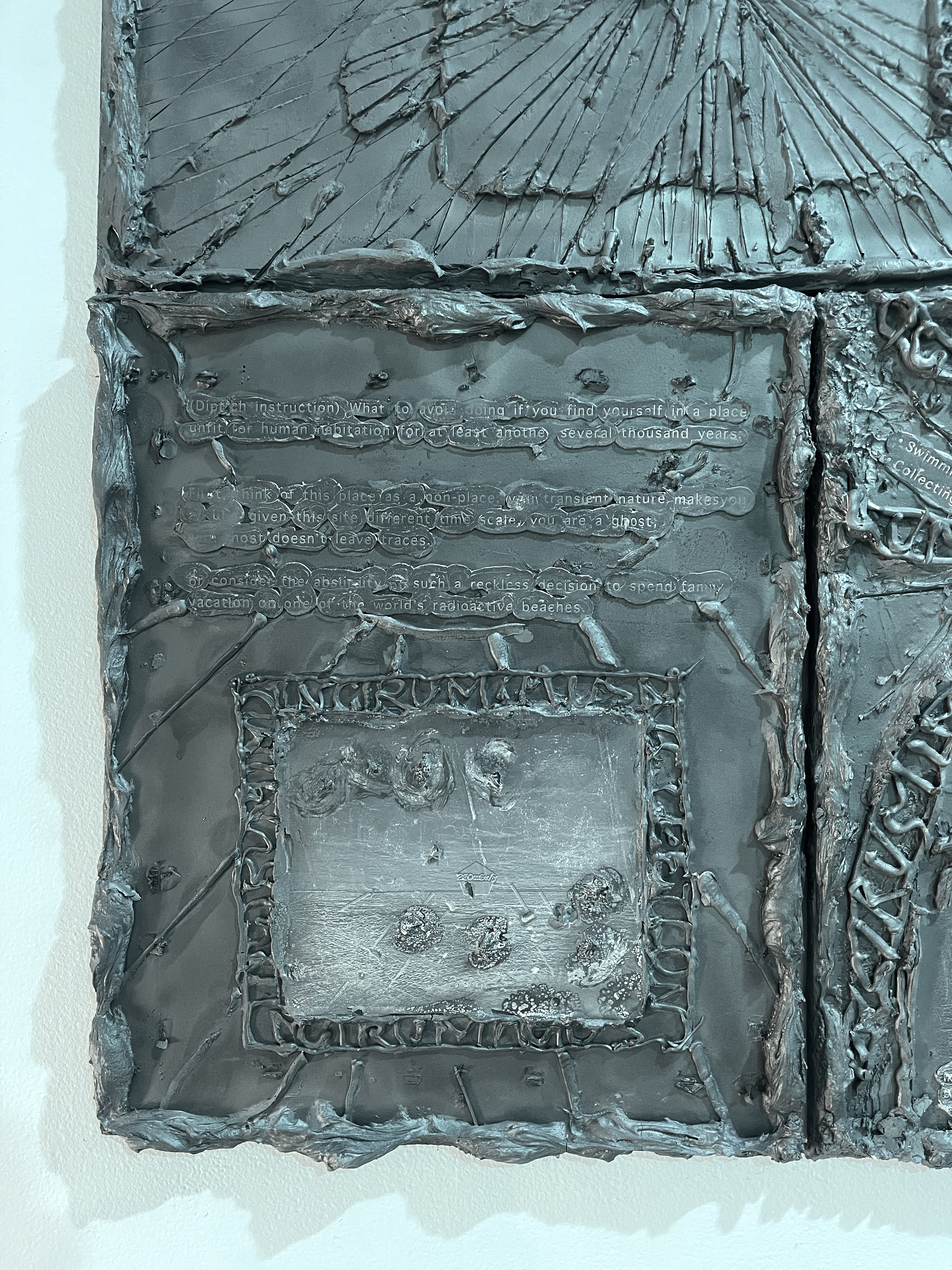
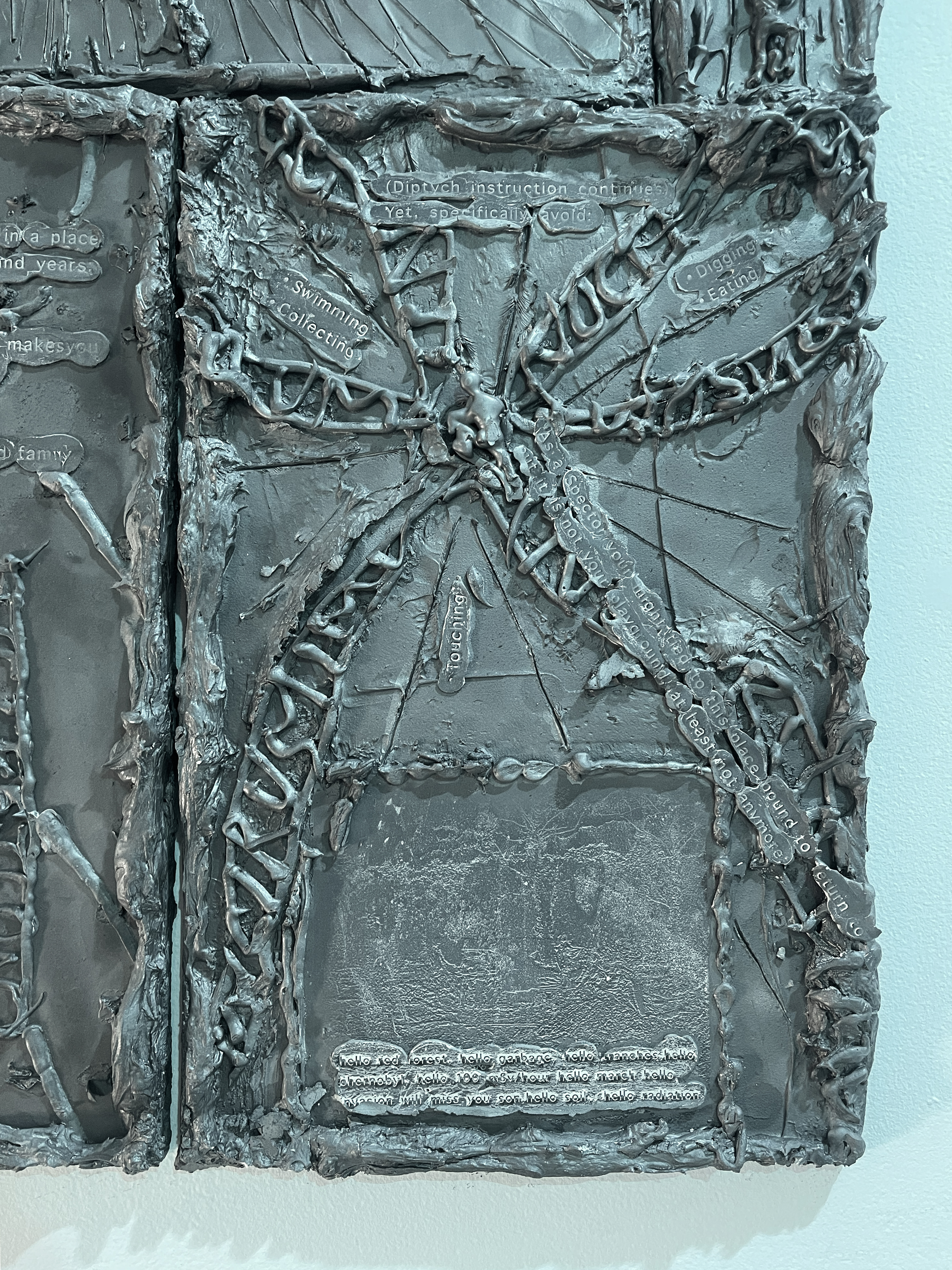
text of poem:
hello red forest, hello garbage, hello trenches, hello 100 mrv/hr, hello march, hello invasion, hello will miss you son, hello soil, hello radiation

lead pig (one day this sadness will fossilize) features uranium ore and a Geiger counter housed in a piglet-shaped jar, referencing nuclear waste containers known as “lead pigs.” The amplified Geiger sounds from radioactive emissions create a surreal and interobjective non-human performance. This work reflects on and critiques our ecological tendency to look away and conceal issues behind a picturesque facade, instead promoting a stance of active care and genuine coexistence with the environment—a space we continually shape and for which we remain responsible.


lead pig (one day this sadness will fossilize), 2024, dimensions variable, uranium ore, geiger counter, ceramics, sound amplifying system, wood, relief compound, pigment spray, lead, glass



(piglet instruction or how to safely store the radioactive materials), 2024, 20x20 in, wallboard base, relief compound, spray pigment, archival ink
Text of instruction:
Care of them consciously and store them above ground in monitored, secure space like museum or a gallery until they are no longer radioactive.
Place radioactive materials in suitable containers, such as a lead pig, to ensure maximum containment.
Remember, some of them have half-life almost as distant in the future as the oldest found cave paintings are in our past.

(meta instruction or how to feel radiation), 2024, 20 x 32 in, wallboard base, relief compound, spray pigment, synthetic resin, archival ink
Text of the instruction:
Consider that we leave at the age of hyperobjects
Radiation is just like global warming, economic formations, black holes, avant-garde, and war. It is clinging to everything it touches, refusing to let go. It is seeping into every corner of existence, from the air we breathe to the thoughts we think. It is influencing us as tangibly as the glass you are holding. It it effects outlasting our lifetimes, shifting and morphing over the ages. It is appearing and disappearing based on our attention, lurking in the spaces we don’t see. We are entangled in them, and we are being hypocrite about them and yet we must learn to live alongside them, navigating their complex, all-encompassing presence.
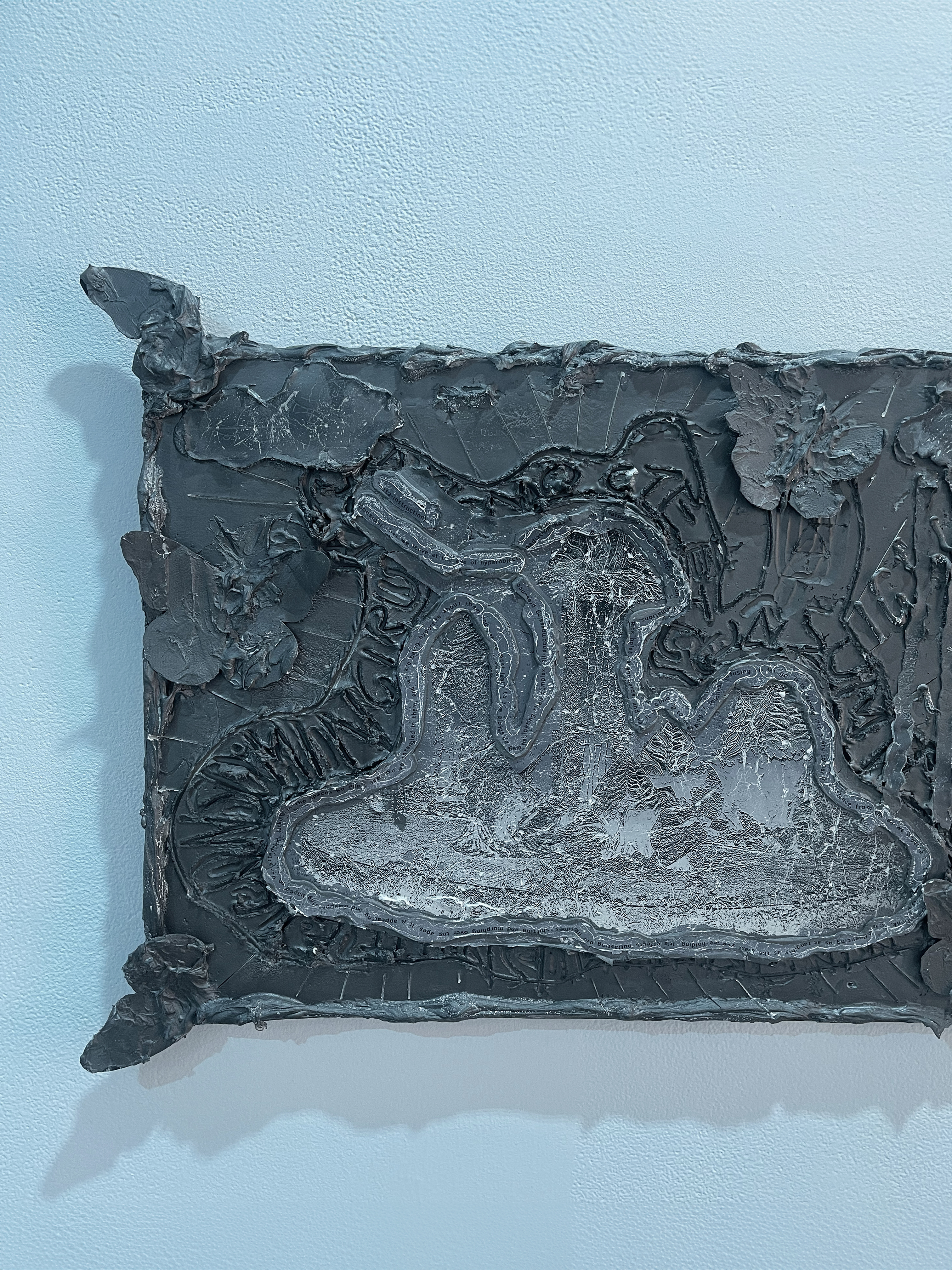
This instruction was also created to establish a lineage with my previous project, a framework first introduced in the Meta-Meta publication. All nine instructions included in this exhibition will form a new sequence in the instruction table, connecting them to other projects within the existing body of work.

exhibtion overview
In response to the unsettling feeling that things remain the same yet have become weird, Pale Grass Blue explores the viscous and porous nature of reality, wherein everything slips into the void when we attempt to grasp it, only to radiate back something that displaces, recurs, and fractures our modes of thought. Everything becomes blurry, hazy, and loopy.
Building upon the ecological thought of philosopher Timothy Morton and his theoretical assertion of the hyperobject, Pale Grass Blue uses its theme of radiation to bring together soft tissue, light, spray paint, construction waste, walls —creating a shimmering landscape of objects, installations, and remnants of text.
Some of these elements and materials are specific to the handling of radioactive substances or even include them; others evoke notions of shelter-like constructions and shielding, or reflect our common use and perception of radiation, such as X-ray boxes, floodlight elements, and textual instruction within the installation. This diversity of media and materials is intended to contribute to the exhibition's main theme and demonstrate how these various forms of representation and appearance inescapably cling to our everyday lives, seeping their toxins into the fabric of the socio-political environment and geographical landscapes in which we live.
In this regard, radiation flickers, rendering every object its own Geiger counter, reminding us of events that have transpired and will continue to effect change long after we are gone. Ecocide, wars, body politics, avant-garde, black holes, religion, and capital—each constitutes a radioactive event that alters and reshapes the genome of what we term reality, akin to scratchy rays that, once observed, burn and mutilate, leaving everything new, othered, and bizarre, like the wings of a mutated Pale Grass Blue.